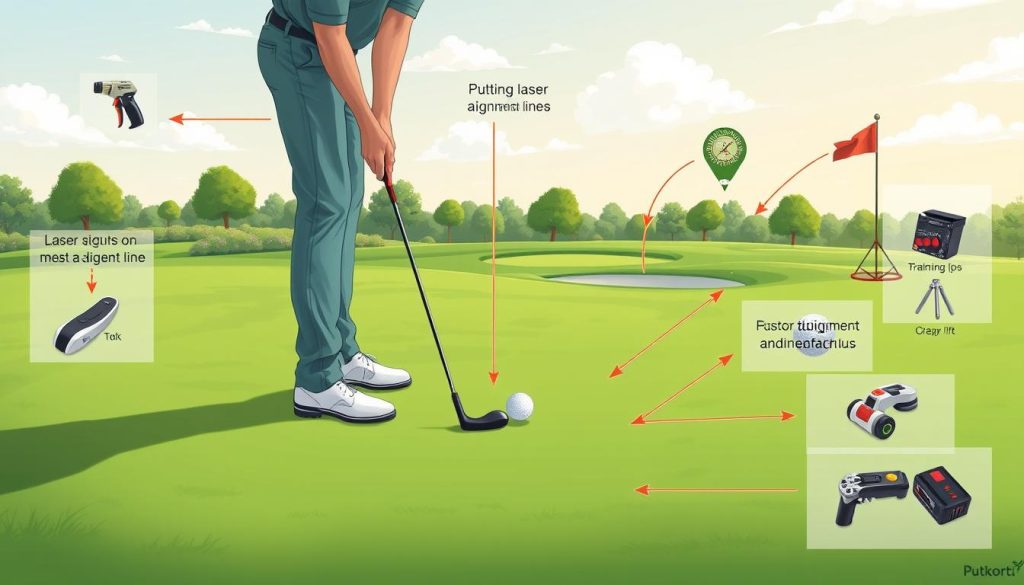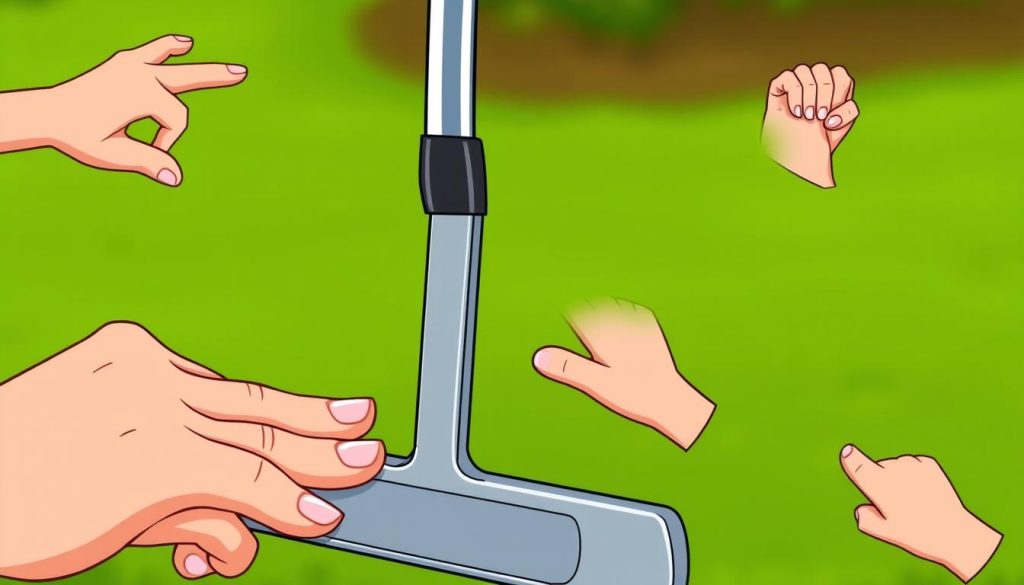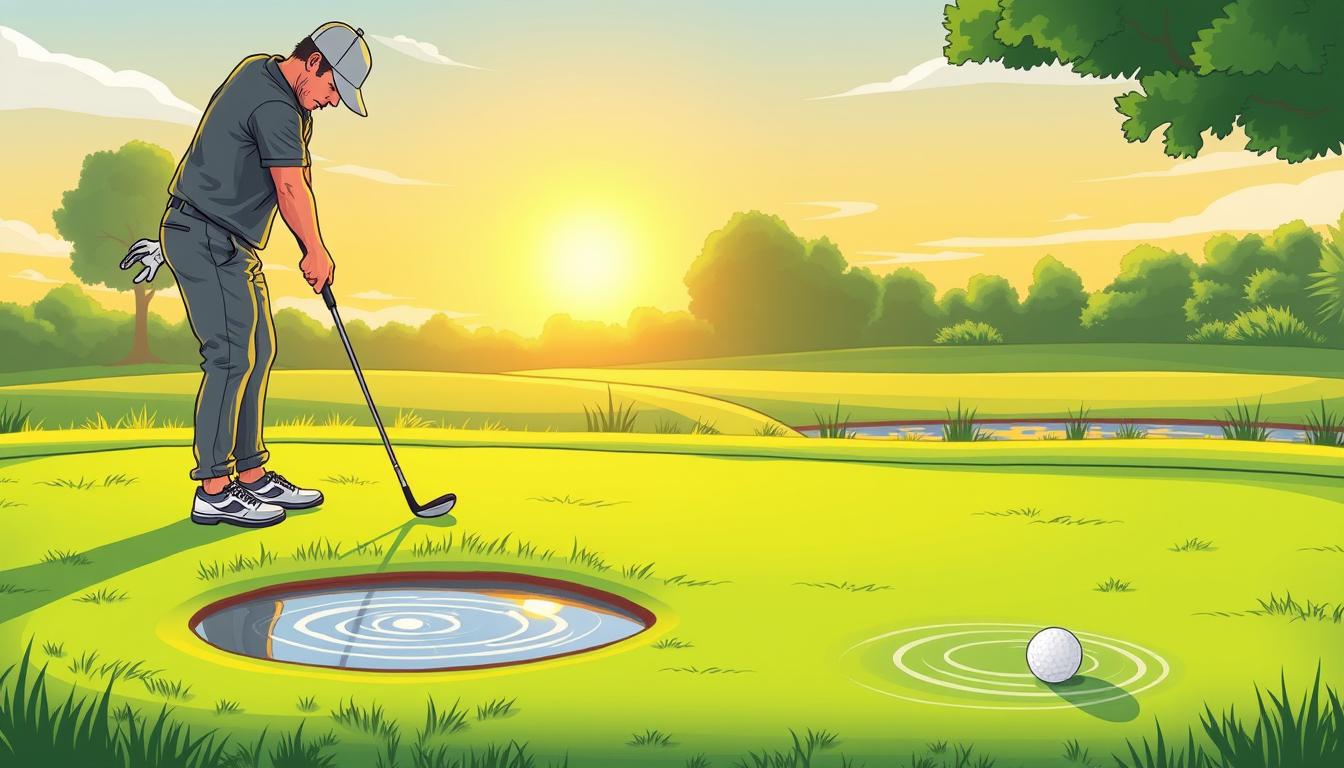Do you struggle with your putting stroke? You’re not alone. Both golf pros and amateurs face challenges with this key part of the game. This guide, based on over 1,000,000 golf swings and putting strokes, offers valuable insights. It helps improve your putting consistency and overall performance on the green.
We’ll cover the basics of a successful putting stroke. This includes mastering wrist motion and perfecting stroke tempo. Whether you want to lower your handicap or feel more confident on the green, this guide is for you.
Let’s explore putting mechanics, grip techniques, and advanced stroke analysis. By the end of this guide, you’ll know how to fix common putting issues. This will help you improve your golf game and score lower.
Key Takeaways
- Wrist motion control is crucial for consistent putting
- Maintain a 2:1 ratio in downswing to backswing timing
- Focus on path and face control for accurate putts
- Grip consistency greatly impacts stroke consistency
- Smooth takeaway and transition are vital for putting success
- Regular practice is key to improving putting skills
Understanding the Fundamentals of Putting Mechanics
Putting is the ultimate test of precision in golf. A perfect putt combines speed, aim, and stroke. To master this art, you need to understand key mechanics that affect your putting.
The Role of Wrist Movement
Wrist motion is key in putting. Pros keep their wrists still for consistency. But, amateurs often move their wrists too much, leading to bad putts. The HackMotion wrist sensor helps golfers improve by measuring wrist movement.
Path and Face Control Basics
The putting arc and clubface control are crucial for accuracy. Even when aiming straight, a slight arc in your stroke is natural. The putter’s face angle at impact greatly affects the ball’s direction.
| Putting Element | Impact on Performance |
|---|---|
| Wrist Motion | Affects consistency and control |
| Putting Arc | Influences ball path and accuracy |
| Clubface Control | Determines initial ball direction |
Impact Position Essentials
The impact position is key for direction and distance control. Your hands should be slightly ahead of the putter at impact. This helps maintain stability and ensures the ball rolls quickly.
By focusing on these basics, you’ll improve your putting stroke. Consistency in grip, path, face control, and tempo are essential for great putting mechanics.
Mastering the Perfect Putting Stroke Setup
A solid putting setup is key to a consistent stroke. Your setup, alignment, stance, and ball position are crucial for sinking more putts. Let’s dive into how to master these elements to boost your green performance.
Begin with your alignment. Use a putting mirror to align your eyes over the ball. This makes the intended line clearer. Stand with your feet shoulder-width apart for stability. Place your ball slightly forward of center for a smooth strike.
Work on your stance by keeping your knees slightly bent and hips hinged. This allows for a smooth stroke. Keep your arms relaxed and hanging from your shoulders for a free-flowing stroke.
Regularly practice your setup to build muscle memory. Even PGA Tour pros only make about 50% of their 8-foot putts. Mastering your setup boosts your chances of success on the green.
| Element | Key Points |
|---|---|
| Alignment | Eyes over ball, use putting mirror |
| Stance | Shoulder-width apart, slight knee flex |
| Ball Position | Slightly forward of center |
| Posture | Hinge from hips, arms relaxed |
Remember, putting greens have the ball 3-5mm deep in the grass. This shows how important a proper setup is for clean contact. Focus on these basics to build a solid putting stroke.
The Science Behind Putting Stroke Tempo
Mastering putting tempo is crucial for better golf. The right timing can greatly improve your putting. Let’s dive into the science and how to use it to boost your green game.
The 2:1 Ratio Principle
The 2:1 ratio is key in putting tempo. Your downswing should be twice as fast as your backstroke. This ratio leads to a smooth, controlled stroke. Practice this rhythm to get better at all putt lengths.
Using Metronome Training
Metronome training helps you keep a steady tempo. Use a metronome at 72-80 beats per minute. Practice your stroke with this rhythm to build muscle memory for reliable putting.
Tempo Variations for Different Distances
While the 2:1 ratio stays the same, adjust your stroke length for different distances. For longer putts, make your backstroke longer but keep the same tempo. This helps control distance without messing up your timing.
| Putt Distance | Backstroke Length | Tempo Ratio |
|---|---|---|
| Short (3-6 feet) | 4-8 inches | 2:1 |
| Medium (7-20 feet) | 9-16 inches | 2:1 |
| Long (20+ feet) | 17+ inches | 2:1 |
Consistent tempo is key for good stroke mechanics and control. Practice these methods to improve your putting stroke.
Putting Stroke Troubleshooting Guide
Mastering your putting stroke is all about analyzing your stroke and spotting common faults. This guide will show you how to find and fix these issues. This way, you can improve your game.
Let’s start by looking at some key statistics:
- Over 1,000,000 swings and putting strokes have been analyzed to determine best practices
- HackMotion technology can establish a baseline for your putting stroke and check consistency
- The optimal putting stroke ratio is 60:40 for all putts
Knowing these numbers helps us see where we can get better. Now, let’s dive into common faults and how to fix them:
| Fault | Symptom | Correction Technique |
|---|---|---|
| Inconsistent wrist motion | Pushing or pulling putts | Practice clockwise rotation for opening face, counter-clockwise for closing |
| Improper tempo | Over-acceleration through impact | Use metronome training to achieve 60:40 stroke ratio |
| Path control issues | Off-line putts | Keep putter face low and shaft vertical during stroke |
| Face control problems | Inconsistent ball direction | Focus on straight line from weak arm to putter grip at finish |
To find these issues, use video analysis or tools like HackMotion. Record 10 consecutive putts to spot miss patterns. Then, create drills to fix your specific problems.

Good putters have a shorter follow-through than backstroke, keeping speed constant through impact. Practice good mechanics to build muscle memory for consistent strokes. With regular practice and stroke analysis, you’ll see big improvements in your putting.
Common Path and Face Control Issues
Understanding putting path and face control is key to better golf. These factors greatly affect your putt’s direction and accuracy. Let’s look at common problems and how to solve them to improve your putting.
Out-to-In Path Problems
An out-to-in path often leads to pulled putts. This happens when your putter moves from outside to inside the target line. To fix it, aim to keep your putter head moving straight back and through along your target line.
In-to-Out Path Solutions
An in-to-out path usually results in pushed putts. Use a putting string training aid to guide your clubhead path. This visual aid helps keep your stroke straight, reducing pushed putts.
Face Angle Control Techniques
Accurate putting relies on face control. A square path with a closed face misses left, while an open face misses right. To improve, try these techniques:
- Use your dominant hand to control the putter face
- Practice with each hand separately to find better control
- Maintain a light, relaxed grip for smoother strokes
- Focus on keeping the putter face square at impact
Even a small misalignment in face angle can lead to missed putts. On a 10-foot putt, being off by just 2 degrees can miss the hole. Aim for consistent stroke direction and face control to boost your putting accuracy.
| Path Issue | Face Angle | Result |
|---|---|---|
| Out-to-In | Square | Pulled Putts |
| In-to-Out | Square | Pushed Putts |
| Square | Closed | Misses Left |
| Square | Open | Misses Right |
Grip Consistency and Hand Position
Your putting grip is the base of a good stroke. Keeping your hands in the same spot helps control the putter. Different grips work for different people, but keeping pressure steady is crucial.
Styles like conventional, lead-hand low, and claw can all work. The best grip is one that feels right and lets you repeat your stroke well.

- Initial grip issues led to a 2.4 degree left deviation
- Consistent path improvement reduced deviation from 2.4 to 0.6 degrees left
- Grip adjustments resulted in more aligned stroke direction
- Enhanced ball striking was evident through narrower hit groupings
Use a wrist sensor to check your grip during practice. It helps you see how your hands are positioned, leading to better putting.
| Grip Type | Benefits | Recommended For |
|---|---|---|
| Conventional | Popular, widely used | Most golfers |
| Left-hand low | Reduces wrist action | Players with handsy strokes |
| Claw | Improves face control | Golfers seeking stability |
A relaxed grip lets your stroke flow smoothly. Try different pressures to find what works best for you. Focus on keeping your grip and hand placement consistent to improve your putting.
Perfecting Your Takeaway Motion
The putting takeaway is key for a good stroke. It sets up your backswing and affects how you start your stroke. A good takeaway keeps your putter low and controlled, leading to better putts.
Low and Controlled Movement
Your putting takeaway should be smooth and steady. Keep the putter head close to the ground as you start your backswing. This low movement helps keep control and boosts accuracy.
Practice this motion on a putting green or synthetic turf at home. It helps build muscle memory.
Avoiding Common Takeaway Mistakes
Many golfers make mistakes with their takeaway. One common error is lifting the putter head too quickly. This can mess up your entire stroke. Another problem is jerky movements during stroke initiation. Aim for a smooth motion from setup to backswing.
Use a putting mirror to check your takeaway form. It gives you visual feedback on your shoulder alignment and eye position. The Putting Plane, a training aid, can also help. It has adjustable rails that guide your putter head along the right path.
- Keep arms and body in sync during takeaway
- Avoid tension in hands and arms
- Practice on various surfaces to improve skills
- Use training aids for instant feedback
Even experienced golfers sometimes struggle with takeaway form. Regular practice and proper technique will help you make more consistent putts and lower your scores on the green.
Advanced Stroke Analysis Techniques
Take your putting to the next level with modern stroke analysis. Tools like SAM PuttLab give you deep insights into your putting. It looks at six key areas: setup, direction, path, launch, rotation, and movement. With its precise data and feedback, SAM PuttLab allows golfers to identify specific weaknesses and improve consistency on the greens. The putting stroke techniques breakdown provided by such tools ensures that every aspect of your stroke is analyzed for maximum efficiency. By addressing these detailed insights, you can make targeted adjustments and elevate your short game performance.
Tracking these metrics helps you understand your putting better. You’ll see trends and know where to improve. It’s all about using tech and feel to get better.
Tracking your performance is key to getting better at putting. Use these techniques to see how you’re doing and make smart changes. With practice and using data wisely, you’ll get better at putting.
FAQ
How important is wrist motion in the putting stroke?
What is the ideal putting stroke tempo?
How can I improve my putting setup?
What are some common path and face control issues in putting?
How important is grip consistency in putting?
What should I focus on during the putting takeaway?
How can I use advanced technology to improve my putting stroke?
Is a straight back, straight through putting stroke the only correct technique?
Source Links
- https://pyramidgolf.com/blogs/news/10-common-putting-mistakes-and-how-to-avoid-them
- https://hackmotion.com/putting-stroke-tips/
- https://skillest.com/blog/master-the-art-of-golf-putting-a-comprehensive-guide-for-beginners/
- https://golfinsideruk.com/putting-technique-the-putting-stroke-explained/
- https://face-on-putting.com/basic-setup/
- https://golfinsideruk.com/golf-putting-tips-lower-score/
- https://rotaryswing.com/golf-instruction/putting/perfect-putting/perfect-putting-technique-stroke
- https://www.golfsmartacademy.com/golf-instruction/length-of-back-swing/
- https://golf.com/instruction/putting/data-reveals-optimal-stroke-length-make-putts/
- https://hackmotion.com/wrist-action-in-putting/
- https://proputtsystems.com/dave-stockton-signature-putting/?srsltid=AfmBOorIwfor2JDaP8Xdqq0cFF26cuml7LZoqlrkYpfY5kRZwPYgJM9-
- https://rotaryswing.com/golf-instruction/putting/hand-dominance-in-putting
- https://pyramidgolf.com/blogs/news/top-10-putting-stroke-tips-for-a-smooth-steady-roll
- https://rotaryswing.com/c4/112382-left-hand-grip-for-perfect-putting-stroke
- https://golf.com/instruction/putting/putting-grips-guide-jim-murphy/
- https://skillest.com/blog/putting-like-brad-faxon-tips-to-improve-your-putting-stroke/
- https://golfgreens.com/golf-pro-tips/what-should-a-proper-takeaway-feel-like/
- https://rotaryswing.com/golf-instruction/putting/golf-putting-acceleration-drill
- https://www.aans.org/patients/conditions-treatments/a-neurosurgeons-guide-to-stroke/
- https://www.stroke.org/en/life-after-stroke/stroke-rehab/post-stroke-exercise-videos
- https://www.ncbi.nlm.nih.gov/books/NBK598564/


